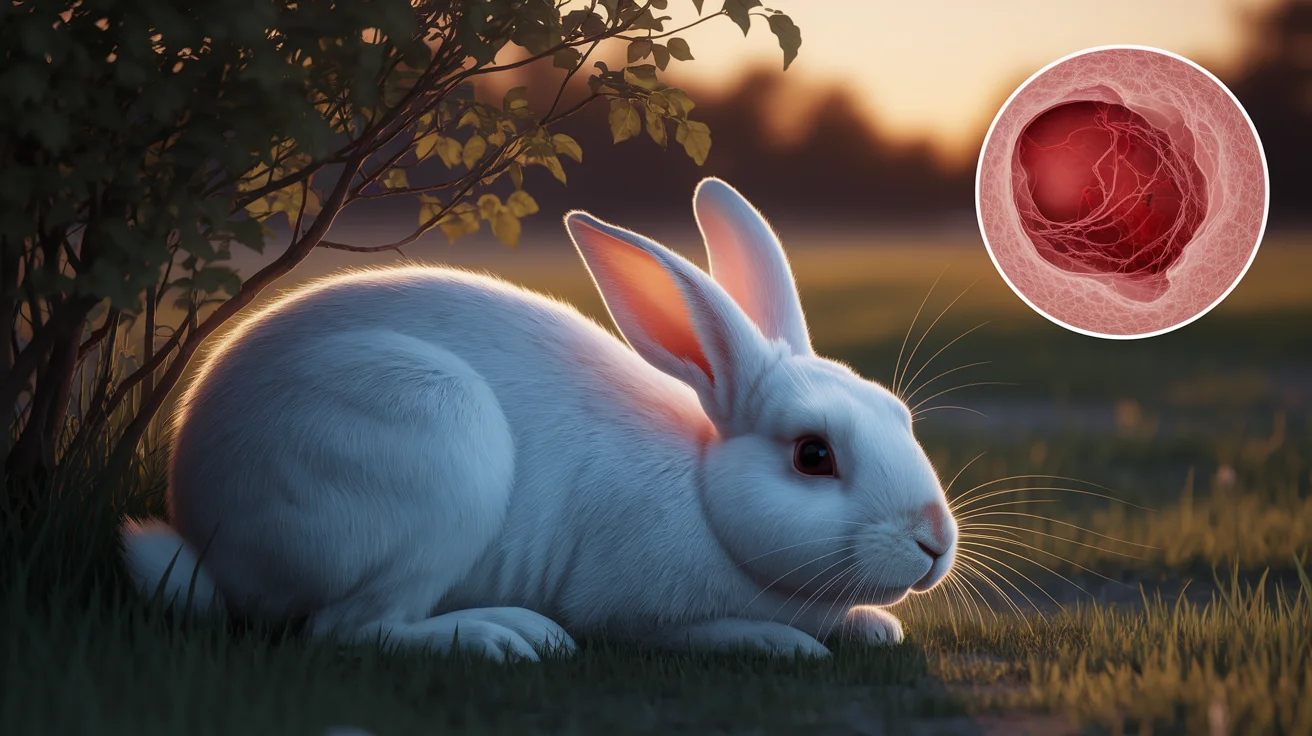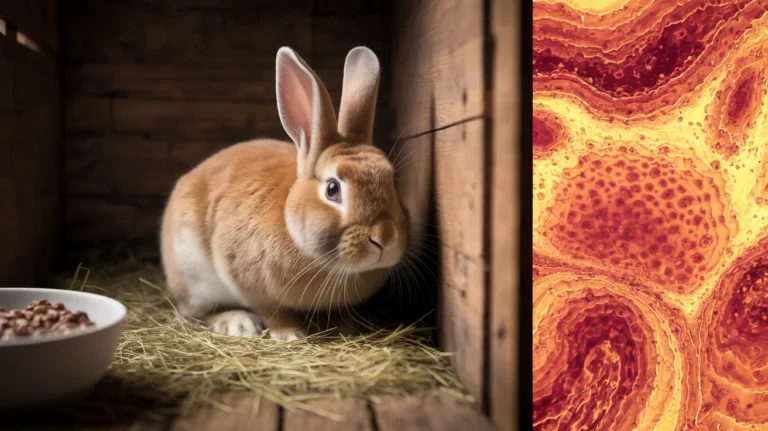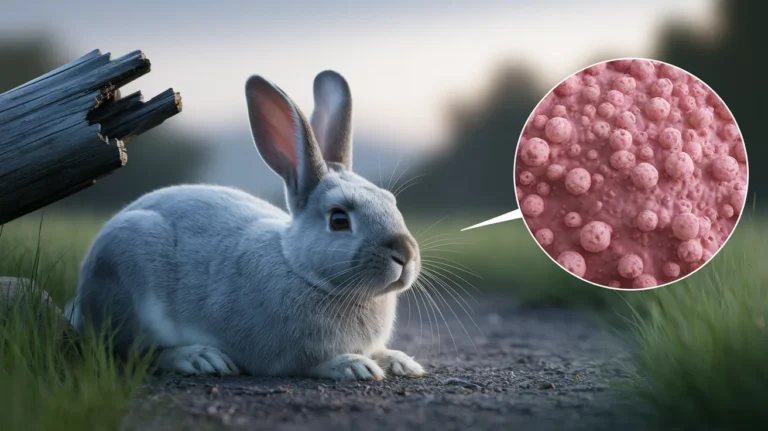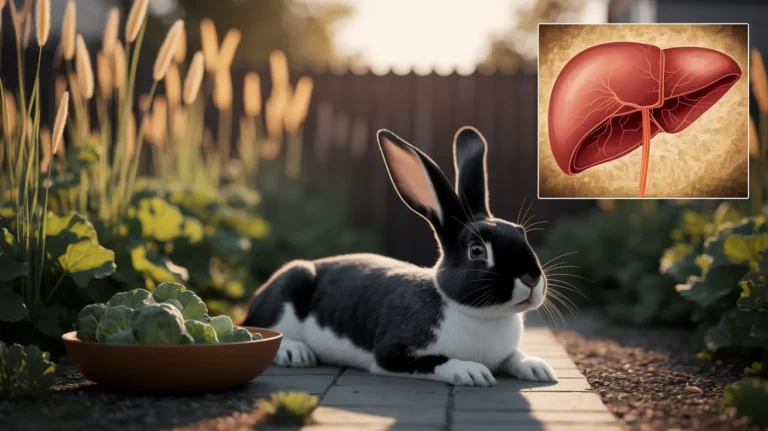Rabbit Hemorrhagic Disease RHD threatens pet rabbits with up to 90% mortality. Learn 7 crucial facts about symptoms, prevention, and vaccines every owner needs to know.
Rabbit Hemorrhagic Disease RHD has emerged as one of the most significant health threats facing domestic and wild rabbits worldwide. This highly contagious viral disease has devastated rabbit populations across multiple continents, with mortality rates reaching up to 90% in unvaccinated animals. For rabbit owners, understanding RHD isn’t just important—it’s essential for protecting your beloved pets from this potentially fatal condition. Whether you’re a long-time rabbit enthusiast or a new bunny parent, this comprehensive guide will equip you with the critical knowledge needed to recognize, prevent, and respond to Rabbit Hemorrhagic Disease. By familiarizing yourself with these seven crucial facts about RHD, you’ll be taking a vital step toward safeguarding your rabbit’s health and well-being.
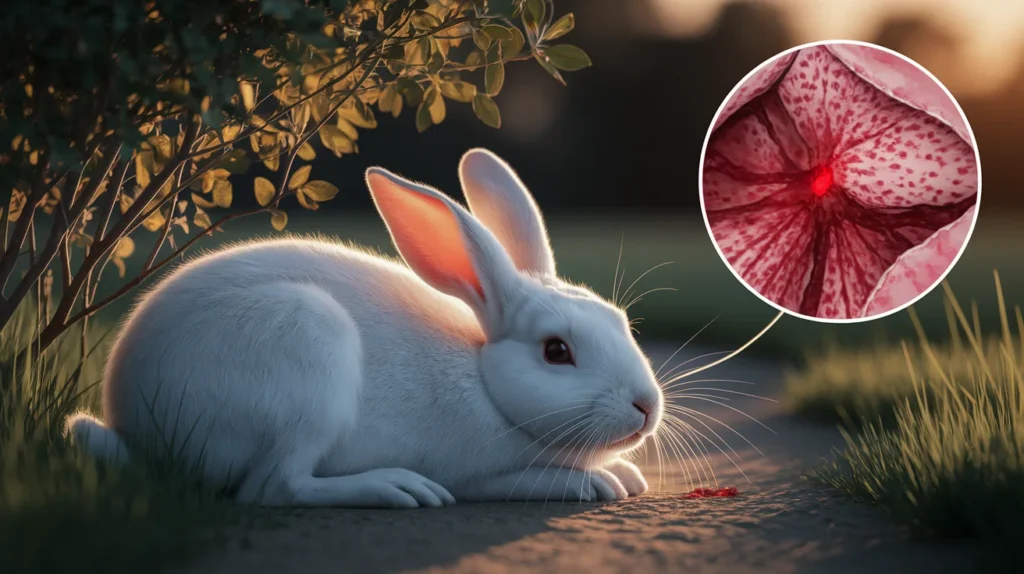
Table of Contents
What is Rabbit Hemorrhagic Disease RHD?
Rabbit Hemorrhagic Disease is a highly infectious viral disease caused by the calicivirus strains RHDV1 and RHDV2. First identified in China in 1984, RHD has since spread globally, becoming a significant concern for both wild rabbit populations and domestic rabbit owners. The disease is characterized by its rapid onset, high mortality rate, and internal hemorrhaging in affected rabbits.
Historical Context and Spread
RHD has a complex history that’s important for understanding its current impact:
- 1984: First identified in Angora rabbits imported from Germany to China
- 1986-1990: Spread rapidly throughout Europe
- 1995: Reached Australia and was intentionally released for rabbit population control
- 2000: First reported cases in North America
- 2010: RHDV2 variant emerged in France, showing ability to affect younger rabbits and additional lagomorph species
- 2018-Present: Multiple RHDV2 outbreaks across the United States, with significant spread in the Southwest and West Coast regions
Today, Rabbit Hemorrhagic Disease has been reported on every continent except Antarctica, making it a truly global concern for rabbit populations.
Fact 1: RHD is Extremely Contagious and Deadly
The first crucial fact every rabbit owner must understand is just how contagious and lethal RHD can be. This disease is not something to take lightly, as it spreads rapidly and often results in death.
Transmission Methods
RHD spreads through multiple pathways:
- Direct contact with infected rabbits or their bodily fluids
- Contaminated food, water, and bedding
- Contaminated surfaces including cages, feeding equipment, and clothing
- Insect vectors like flies and mosquitoes can carry the virus
- Birds and predators can spread the virus after consuming infected rabbits
- Human carriers on shoes, clothing, or hands
The virus can survive in the environment for extended periods—up to 105 days at room temperature and potentially several months in ideal conditions. This environmental persistence makes RHD particularly challenging to control once established in an area.
Mortality Rates
The statistics regarding RHD mortality are sobering:
- RHDV1: 70-90% mortality rate in adult rabbits
- RHDV2: 50-70% mortality rate, but affects rabbits of all ages (including kits under 4 weeks)
- Time from infection to death: Often just 24-72 hours
- Survival rates: Very low without prompt veterinary intervention
Dr. Frances Harcourt-Brown, a leading rabbit veterinary specialist, notes that “RHD is one of the most rapidly fatal diseases seen in any mammalian species, with death often occurring before owners notice any signs of illness.”
Fact 2: Symptoms Can Be Difficult to Detect Before It’s Too Late
One of the most challenging aspects of RHD is that rabbits may show few or no symptoms before sudden death occurs. This makes vigilant monitoring and preventative measures absolutely essential.
Common Symptoms (When Present)
- Fever (over 104°F/40°C)
- Lethargy and depression
- Loss of appetite
- Difficulty breathing or rapid breathing
- Bloody discharge from nose, mouth, or rectum
- Neurological signs like incoordination, excitement, or paralysis
- Vocalization (crying out) due to pain
- Convulsions shortly before death
Clinical Presentation Patterns
RHD may present in three different forms:
- Peracute form: Sudden death with no prior symptoms (most common)
- Acute form: Brief illness lasting 1-3 days before death
- Subacute/chronic form: Milder symptoms with potential for recovery (uncommon)
According to data from the World Organisation for Animal Health (WOAH), approximately 70% of RHDV2 cases fall into the peracute category, meaning owners never observe symptoms before finding their rabbit deceased.
Laboratory Findings
For veterinarians, RHD typically shows these patterns:
- Elevated liver enzymes
- Blood clotting abnormalities
- Microscopic evidence of liver necrosis
- Presence of viral antigens in tissues
Fact 3: RHDV2 Has Changed the Threat Landscape
The emergence of RHDV2 (sometimes called RHDVb) has significantly altered the RHD threat profile. This variant differs from the original RHDV1 in several important ways that rabbit owners should understand.
Key Differences with RHDV2
| Characteristic | RHDV1 | RHDV2 |
| Age susceptibility | Adult rabbits (>8 weeks) | All ages (including kits <4 weeks) |
| Species affected | European rabbits only | European rabbits, hares, and some non-European rabbit species |
| Vaccine protection | Original RHD vaccines effective | Requires specific RHDV2 vaccine |
| Mortality rate | 70-90% | 50-70% (but more widespread) |
| Incubation period | 1-3 days | 3-5 days |
| Geographic range | More limited | Now dominant in many regions |
Recent Outbreaks and Spread
RHDV2 continues to emerge in new regions:
- As of 2023, RHDV2 has been reported in 37 U.S. states
- The Southwest and West Coast have seen multiple significant outbreaks
- Canadian provinces including British Columbia, Alberta, and Ontario have confirmed cases
- Urban areas with high rabbit populations (both domestic and feral) are particularly vulnerable
Dr. Susan Kelleher, an exotic animal veterinarian, emphasizes that “RHDV2 represents a new chapter in rabbit medicine, requiring owners to be more vigilant than ever about biosecurity and vaccination.”
Fact 4: Prevention Through Vaccination is Crucial
With the high mortality rate and rapid progression of RHD, prevention through vaccination represents the most effective protection strategy for rabbit owners.
Available Vaccines
Several vaccines have been developed to protect against RHD:
- Eravac: Protects against RHDV2, licensed in many countries
- Filavac VHD K C+V: Bivalent vaccine protecting against both RHDV1 and RHDV2
- Nobivac Myxo-RHD PLUS: Protects against myxomatosis and both RHDV variants
- Medgel RHDV K5 Vaccine: Used primarily in Australia
In the United States, RHDV2 vaccines have received emergency use authorization in affected states. The USDA granted full approval for the Medgel RHDV2 vaccine in October 2021, making it more widely available to American rabbit owners.
Vaccination Schedule
Typical vaccination protocols include:
- Initial vaccination: From 4-6 weeks of age (depending on the specific vaccine)
- Booster: 2-4 weeks after initial vaccination
- Annual revaccination: Required for continued protection
- Emergency vaccination: Recommended when outbreaks occur in your region
A 2022 study published in the Journal of Veterinary Medicine showed that properly vaccinated rabbits had a 98.7% survival rate when exposed to RHDV2, compared to just 7.2% in unvaccinated controls.
Availability and Access
Vaccination availability varies by region:
- In outbreak areas, emergency authorization often makes vaccines more accessible
- Veterinarians specializing in exotic pets are most likely to stock RHD vaccines
- Some regions require importation of vaccines under special permits
- Cost typically ranges from $25-$75 per rabbit per vaccination
Fact 5: Biosecurity Measures Are Essential (Even for Indoor Rabbits)
Even if vaccination isn’t immediately available in your area, implementing strict biosecurity measures can significantly reduce your rabbit’s risk of contracting RHD.
Essential Biosecurity Protocols
For Indoor Rabbits:
- Wash hands thoroughly before and after handling your rabbit
- Change clothes and shoes after visiting other rabbits or potentially contaminated areas
- Quarantine new rabbits for at least 14 days
- Use dedicated equipment for each rabbit if you have multiple pets
- Clean and disinfect cages and equipment regularly with RHD-effective disinfectants
- Control insect vectors by using screens on windows and doors
- Avoid collecting forage from areas where wild rabbits may be present
For Outdoor Rabbits:
- Elevate hutches off the ground
- Use fine mesh screening to prevent direct contact with wild rabbits
- Create double barrier systems around rabbit housing
- Implement pest control measures to reduce insect vectors
- Disinfect all equipment regularly
- Control access to your rabbit area (no visitors who have contact with other rabbits)
- Consider transitioning to indoor housing in high-risk areas
Effective Disinfectants
Not all disinfectants are effective against the RHD calicivirus. Research has shown these to be most effective:
- 10% bleach solution (1 part bleach to 9 parts water)
- Accelerated hydrogen peroxide products
- Potassium peroxymonosulfate (Virkon-S)
- 2% formaldehyde
- 1% sodium hydroxide
Always ensure proper contact time (typically 10 minutes) and thorough rinsing before allowing rabbit contact with disinfected surfaces.
Fact 6: RHD is a Reportable Disease That Requires Professional Response
Rabbit Hemorrhagic Disease is classified as a reportable disease in most countries, including the United States. This has important implications for rabbit owners.
Reporting Requirements
If you suspect RHD in your rabbit:
- Contact your veterinarian immediately
- Do not transport dead rabbits without professional guidance
- Report to state veterinarian or animal health authorities
- Cooperate with any investigations or testing requirements
- Follow quarantine directives if issued
In the United States, local requirements can be found through your state’s Department of Agriculture or by contacting the USDA Animal and Plant Health Inspection Service (APHIS).
Testing and Diagnosis
Accurate diagnosis of RHD requires laboratory testing:
- Antigen detection methods: ELISA, RT-PCR
- Histopathology: Examination of liver tissue samples
- Virus isolation: In specialized laboratories
- Electron microscopy: To visualize viral particles
According to the World Organisation for Animal Health, liver samples are the preferred specimen for definitive diagnosis, though testing can also be performed on blood and other tissues.
Post-Exposure Management
If exposure is confirmed or strongly suspected:
- Quarantine all potentially exposed rabbits
- Enhanced monitoring for any signs of illness
- Prophylactic vaccination if not previously vaccinated
- Environmental decontamination of all potentially contaminated areas
- Proper disposal of deceased animals according to local regulations
Fact 7: RHD Has Wider Ecological and Economic Impacts
Beyond its devastating effects on pet rabbits, RHD has far-reaching consequences for ecology, conservation, and rabbit-related industries.
Ecological Impact
RHD has dramatically affected wild rabbit populations:
- Australia: Used intentionally for rabbit control, reducing populations by up to 95% in some regions
- Europe: Contributed to an estimated 70% decline in wild rabbit populations since the 1950s
- Endangered predators: Species that depend on rabbits (like the Iberian lynx) face increased extinction risk
- Vegetation changes: Reduced grazing pressure alters plant community composition
- Invasive species: Can gain advantage when rabbit populations decline
Economic Consequences
The economic impact of RHD extends to multiple sectors:
- Rabbit meat industry: Global losses estimated at $2.3 billion since 1984
- Fur production: Significant disruption to angora and other fiber markets
- Laboratory animals: Increased costs for biomedical research facilities
- Veterinary costs: Both preventative and outbreak response expenses
- Tourism: Reduction in wildlife viewing opportunities in some regions
Conservation Implications
For conservation efforts, RHD presents a complex challenge:
- Endangered rabbit species: Several rare rabbit species face extinction risk
- Captive breeding programs: Required for recovery of some populations
- Habitat management: Changes needed to support surviving populations
- Genetic diversity: Loss of genetic variation in surviving populations
- Disease management: Diversion of limited conservation resources
The International Union for Conservation of Nature (IUCN) now lists RHD as a factor in the endangered status of 7 rabbit species worldwide.
FAQ: Rabbit Hemorrhagic Disease
Is RHD contagious to humans or other pets?
No, RHD is not zoonotic and poses no direct health risk to humans. It also does not affect other non-lagomorph pets like cats, dogs, or small rodents. Humans can, however, act as mechanical vectors by carrying the virus on clothing, shoes, or hands.
How long does the RHD virus survive in the environment?
The virus is extremely hardy and can survive for extended periods: up to 105 days at room temperature, over 3 months in dried state conditions, and potentially years in frozen tissues. It can withstand pH ranges from 3-10 and temperatures up to 122°F (50°C).
Can rabbits recover from RHD?
Recovery is rare but possible, especially with the RHDV2 variant which has a slightly lower mortality rate. Supportive care from a veterinarian may improve survival chances, though most infected rabbits do not survive.
Are baby rabbits immune to RHD?
Young rabbits (under 4-8 weeks) were relatively resistant to the original RHDV1. However, RHDV2 affects rabbits of all ages, including very young kits, eliminating this age-related protection.
How is RHD diagnosed?
Definitive diagnosis requires laboratory testing of tissue samples, typically liver tissue, using methods like PCR, ELISA, or histopathology. Clinical diagnosis is difficult due to the rapid progression and non-specific symptoms.
Can wild rabbits transmit RHD to my pet rabbits?
Yes, wild rabbits can serve as reservoirs for the virus. Contact between wild and domestic rabbits (direct or indirect) presents a significant transmission risk, which is why biosecurity measures are crucial even for indoor pets.
Is there treatment for rabbits infected with RHD?
There is no specific antiviral treatment for RHD. Supportive care (fluid therapy, pain management, and nursing care) may help some rabbits survive, but treatment is often unsuccessful due to the disease’s rapid progression.
Recommended Pet Products on Amazon
Rabbit Health Essentials
- Oxbow Critical Care for Herbivores – Emergency nutritional support for rabbits during illness
- Kaytee Clean & Cozy White Small Animal Bedding – Dust-free bedding for proper hygiene
- Living World Lock & Crock Dish – Easy-to-sanitize food dish to maintain biosecurity
- Arm & Hammer Pet Fresh Carpet Odor Eliminator Plus Sanitizer – Helps neutralize viruses in home environments
Protecting Your Rabbit: Next Steps
Understanding Rabbit Hemorrhagic Disease is just the first step in protecting your beloved pet. Take these concrete actions today:
- Contact your exotic veterinarian to discuss vaccination options in your area
- Implement a comprehensive biosecurity protocol for your home and rabbit housing
- Create an emergency plan in case RHD is detected in your region
- Connect with local rabbit owner communities to stay informed about outbreaks
- Consider transitioning outdoor rabbits indoors in high-risk areas
The most important thing to remember is that prevention is significantly more effective than treatment when it comes to RHD. By staying informed and taking proactive measures, you can dramatically reduce your rabbit’s risk.
Conclusion
Rabbit Hemorrhagic Disease represents one of the most significant health threats to domestic rabbits today. Its high contagiousness, devastating mortality rate, and often symptomless progression make it particularly dangerous. However, through proper vaccination, stringent biosecurity measures, and increased awareness, rabbit owners can effectively protect their beloved pets from this disease.
By understanding these seven crucial facts about RHD, you’ve taken an important step toward safeguarding your rabbit’s health. Remember that staying informed about local outbreaks and maintaining open communication with exotic veterinarians who treat rabbits are key components of responsible rabbit ownership in the era of RHD.
We’d love to hear about your experiences with rabbit health management. Have you implemented special biosecurity measures? Has your veterinarian discussed RHD vaccination with you? Share your story in the comments below.
For more expert pet care advice and guides on rabbit health, visit blithepet where you’ll find comprehensive resources to help you provide the best care for your furry companions.

